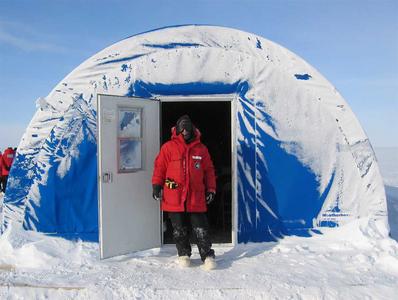11 October, 2003
Happy Camper School. Those words can either bring a smile or a grimace to the faces
of field camp parcticipants. This course is required for anyone who will be spending time
in the field away from the safety of McMurdo’s confines. All new visitors to Antarctica and
those who have had more than 5 years since their last visit are required to take the
course. In the course a group of up to 20 campers (happy or otherwise) spend 2 days
learning some of the fine points of winter camping and survival and applying that newly
gained knowledge as they spend a night camping. The goal of the course is to teach you
knowledge that would be crucial if you were caught out, away from your field camp. In
addition, it gives you a great chance to critically analyze your clothing choices and
decide which layer systems might work the best for you. This is certainly experiential
learning at its finest—the chance to learn important information and apply it immediately
in a relevant situation.
Our course began with an introductory lecture that outlined the goals of the course and
gave us an idea of the schedule. In addition, it gave us a chance to evaluate the thermal
efficiency of our ECW gear while sitting in a heated room. After the lecture it was time to
pack into our Happy Camper Mobile, known as the Nodwell. This slow moving and
extremely loud tracked vehicle carried us away from McMurdo to an area that was,
perhaps 4 or 5 miles away.
Still happy, we trooped into a very slightly heated Jamesway shelter (a semi-permanent
Quonset hut type shelter) for hot beverages and a delicious sandwich and chocolate bar
lunch and a session on stove use and troubleshooting. After the stove orientation it was
time to face the realities of life outdoors. We packed duffel bags with sleep kits consisting
of 2 ensolite pads, a sleeping bag rated to –40F, and a fleece liner for the bag. The kits
were loaded into the Nodwell and we roared (slowly) over to our new home.
Happily (don’t forget, this is Happy Camper School), we exited the vehicle and piled our
sleep kits and ECW gear bags on the snow. The group was directed to a small storage
shed that held tents, bamboo wands, shovels, snow saws, and ice axes. Our mission
was to create a variety of shelters that would provide effective protection from the harsh
Antarctic weather.
We set up 2 types of tents, a Scott Tent and a basic mountaineering tent. The Scott Tent
is a traditional Antarctic tent developed by Robert Scott for his expeditions. They are
easy to put up, stable in high winds, and provide shelter for 4 people (or more, if
needed). The 4-season mountaineering tents are also simple to put up and provide cozy
space for 2 happy campers. We also learned to make a few different snow shelters—
quinzhee huts and snow trenches. Both of these require far more effort than simply
putting up a tent, but the chief advantage comes from the insulative properties of snow. A
snow cave with walls that are 30 cm thick will keep you well insulated from sub-zero
temperatures.
The other key element of Antarctic camping is wind. It is essential to construct some sort
of wind block around your shelter and cooking area to keep the wind from finding its way
into your home. We quarried endless blocks of snow to build elaborate snow walls that
shielded us from the wind. These walls were well appreciated as the winds increased in
the night and were blowing nicely in the morning.
After a calorie-laden dinner (calories = fuel for the inner fire) we settled in for the night.
Perhaps the best part of snow camping in Antarctica in the spring is the fact that it doesn’t
get dark at night—snow camping in the US usually means going to bed at 6pm. We
crawled into our cozy nests around 11pm and settled in for a delightful night. I only woke
a few times and was quite content to stoke my inner fire with a Cadbury chocolate bar
(you don’t want to run out of calories!) to keep me warm through the night.
In the morning we took down tents, put away our sleeping bags, had hot beverages, and
compared notes on who had been the happiest campers of all.
Daily Haiku:
Happy camper school
Scott tents, quinzhees, snow block walls
Stay warm stay happy

The Nodwell; the Happy Camper School vehicle

A Happy Camper

The Happy Camp

Jim and Jonna with their Happy Meals

Still happy in the morning!
Contact the TEA in the field at
.
If you cannot connect through your browser, copy the
TEA's e-mail address in the "To:" line of
your favorite e-mail package.
|
